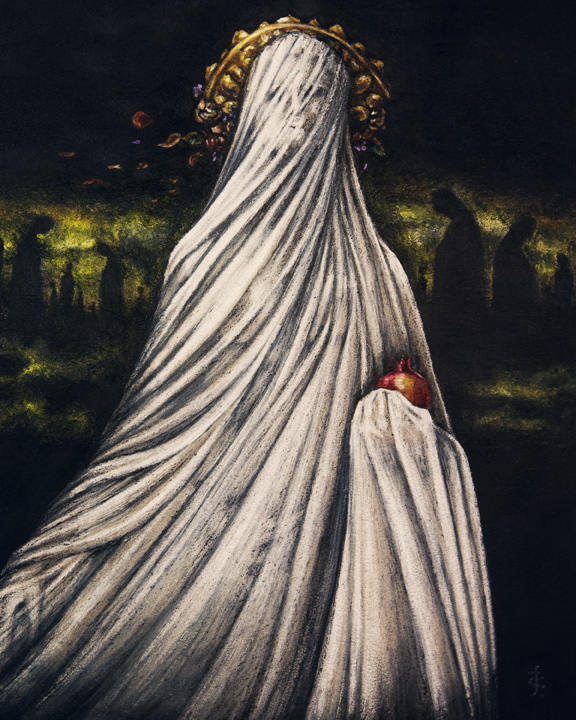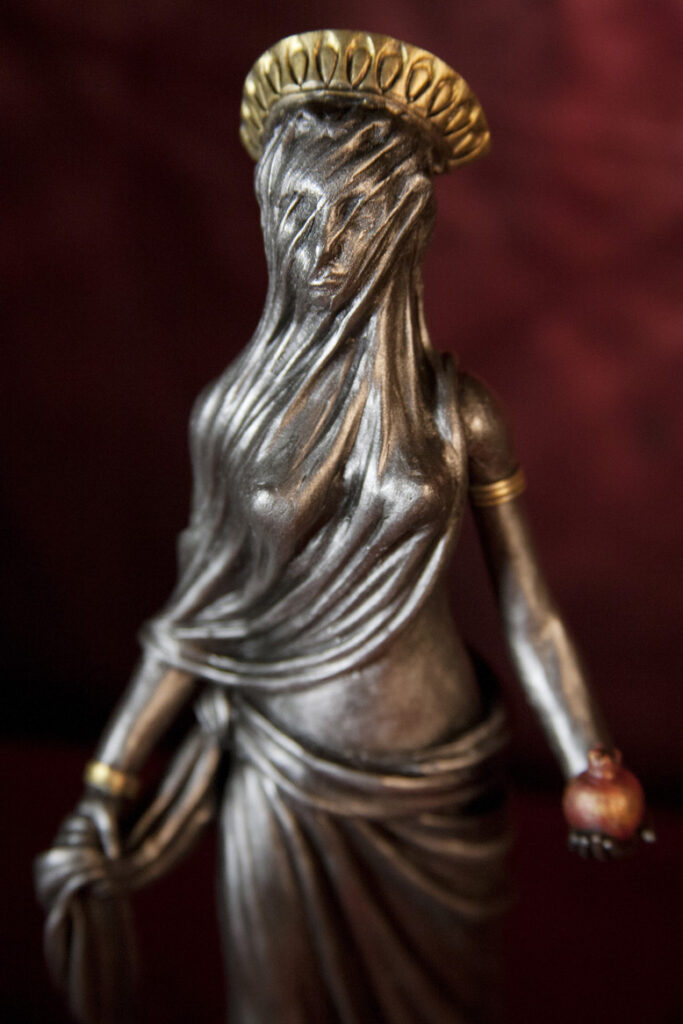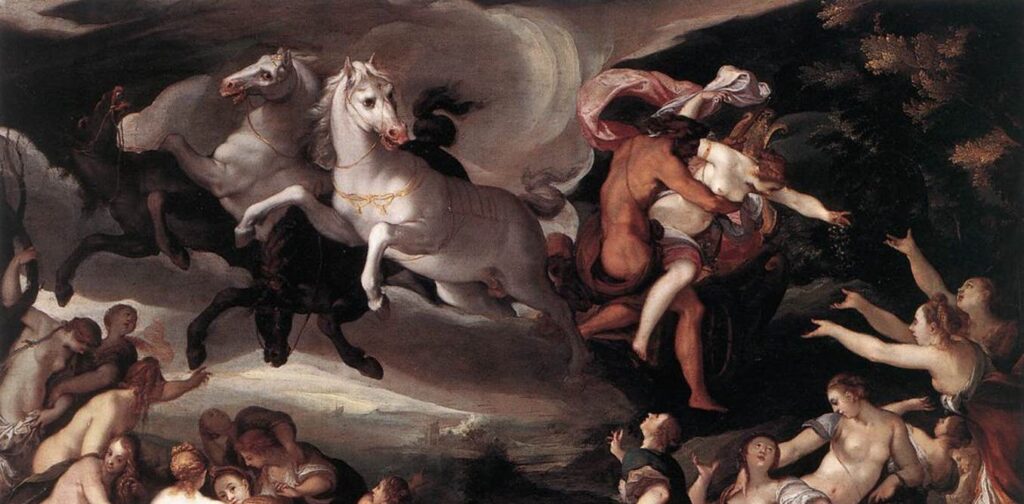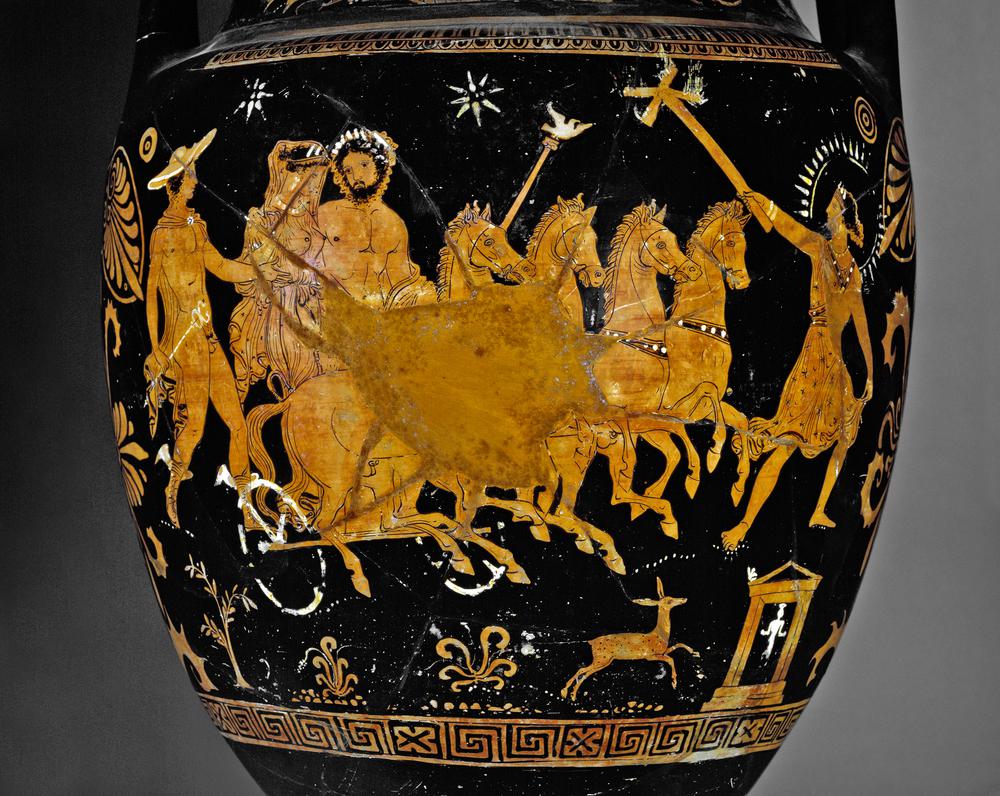
For thousands of years the Greek Gods have endured in the imagination of humankind, kept relevant in the retelling of myths, and kept sacred by the growing number of adherents of revitalized ancient religions. With the popularity of Wicca over the past 60 years, and its Wheel of the Year, the cycles of the seasons are also a big part of celebrating these Gods even among those outside Wiccan traditions. As I write this we are in between two of these festivals, the Spring Equinox on March 20th, or Ostara on the Wiccan calendar, and May 1st, or Beltane. This period marks the beginning of Spring in March, through to its peak at the beginning of May. It is the time we begin to see the harshness of Winter decline, and the arrival of warm air and new growth as the Sun regains its power. For the Hellenic polytheist this is an extremely sacred time, especially for those who worship Persephone, the Goddess of Spring, and Queen of the Underworld. To make Persephone’s descent and return easy for our modern calendar, most polytheists celebrate Her descent on the Autumn Equinox (September 21-23), and Her return on the Spring Equinox (March 19-21). But I think this is incorrect based on not only the symbolic meaning behind the myth, but on the festivals of the ancients themselves.

The primary source for the myth of Persephone’s abduction and Demeter’s mourning comes from the Homeric Hymn to Demeter. The Homeric Hymns are a collection of poems celebrating the Gods, possibly dating from about the 7th century BCE. They are named the “Homeric Hymns” because they are written in the poetic style of Homer’s Iliad and Odyssey which date from the 8th century, or early 7th century BCE. In the hymn Persephone, Goddess of the Plentiful Spring, is abducted by the Underworld God, Hades, as She picks flowers. Demeter discovers Her daughter is missing and wanders the world in inconsolable grief. The world is plunged into a bitter, freezing winter and Demeter stops all plants and leaves from growing. After learning from Hekate and Helios that Persephone was abducted Demeter pleads with Zeus, Persephone’s father, for Her safe return. In this telling of the myth, Persephone is given an unspecified number of pomegranate seeds which binds Her to Hades. She must spend one third of the year in the Underworld with Hades, and two thirds of the year with Demeter. Other authors such as Ovid say Her time is divided equally between Hades and Demeter, so 6 months in the Underworld, and 6 months with Demeter. This difference is primarily due to the concept of the seasons for each culture. While the Romans observed the 4 seasons we recognize today: Spring, Summer, Autumn, and Winter, the Greeks only had three: Spring, Summer, and Autumn, which doubled as Winter.
Persephone is suppose to be escorted to the Underworld, bringing with Her all the flora of Spring. This is often seen as an allegory for the withering and decaying of flowers, leaves, and fruits at Autumn, and their seeds being planted underground in the soil. In ancient Greece, grains such as wheat and barley, the main food source at the time, were planted around the time corresponding to October in mid Autumn, and harvested around May making up the half of the year between crops. This lends significant credence to Ovid’s account because by that time, the myth itself was understood more as the cycle of the harvest, as well as the blooming of flowers. What I personally did when coming up with my dates for celebrating the descent and return of Persephone was look at the whole of texts that describe these events, as well as the seasons themselves.

The Homeric Hymn to Demeter may be the first full written account of the Abduction of Persephone. Its original meaning was most likely not based on the seasons, but rather the storing of grain underground for one third of the year during the Summer months. So originally, Persephone would descend at the start of Summer, and return in Autumn which would seem extremely confusing to modern polytheists who celebrate Her as the Goddess Who heralds the warmer seasons. We know the Homeric Hymn is not the original source of the myth because it is mentioned by Hesiod in his ‘Theogony” which pre-dates the Homeric Hymns, although Hesiod does not go into any detail, just saying Persephone was stolen from Demeter by Hades, given to Him by Zeus. The Homeric Hymns themselves aren’t even original, but a collection of poems that were often re-written, and re-conceptualized, this one specifically recovered from a 15th century CE manuscript (all earlier copies are missing the first hymn to Dionysos, and the second hymn to Demeter), so it isn’t hard to see how the original meaning was lost, and why some of the descriptions in the hymn itself place Her return in Spring rather than Autumn.
When Persephone is finally returned, Zeus decrees “But when the earth starts blossoming with fragrant flowers of springtime, flowers of every sort, then it is that You (Persephone) must come up from the misty realms of darkness…”. This comes from line 401 of the hymn and most likely is proceeded by a description of when She is to descend, however lines 387- 400 are missing. It is clear that every sort of flower is blossoming at the point of Her return signaling it isn’t the beginning of Spring, but later. In another line, Rhea descends from Olympus to summon Demeter Who is embracing Her newly returned daughter. She reaches the Rarian Field (line 450) that should have been thriving with grain, which was stopped by Demeter’s power. At the divine presence of Rhea, Goddess of the Earth, the field springs forth stalks of grain and “the fertile furrows began to be overflow with cut-down ears of grain lying on the ground, while the rest of what was cut down was already bound into sheaves. This happened the moment she [Rhea] arrived from the boundless aether.” (lines 455-57). This means that Persephone returned when all the grain was suppose to be in the process of being harvested which would put it sometime in our April or May, not the Spring Equinox.

We know that the Eleusinian Mysteries were established based specifically on the Homeric Hymn to Demeter, but even the Lesser and Greater Mysteries are separated by about 6 months, the Lesser being held in Anthesterion (February-March) and the Greater Mysteries in Boedromion (September-August) which may have taken place just before the harvest, and just before the planting of seeds in preparation for the farming season. We also know that there is an ancient festival that represents Persephone’s abduction, the Thesmorphia, which took place for three days in our October/November. During this festival women mourned with Demeter, abstained from sex, and avoided foods such as pomegranate seeds which had touched the ground, and some grains. The most striking element of the Thesmorphia is the sacrifice of piglets which were thrown alive into a chasm in the earth. There are a couple interpretations of this ritual act, first being that it represents the abduction of Persephone Herself. The other is based on the description by Lucian of Samosata from the 1st century CE who explains “When the Maiden was carried away by Pluto as she was gathering flowers, at that time in the same place a swineherd Eubouleus was grazing his pigs and they were swallowed up in the chasm with the Maiden. Therefore, in honor of Eubouleus, piglets are thrown into the chasms of Demeter and the Maiden”. This would place Persephone’s abduction, or descent, in our October/November, which coincides with Varro who mentions that the winter season starts in November after the harvest seeds (Persephone) have been planted, as well as Orphic Hymn 28 to Persephone which reads “Espoused in Autumn: life and death alone to wretched mortals from thy power is known”, which indicates that it Her descent coincides with Her original abduction.

So if the descent takes place in October/November, we can either go with the original 4 month timeline from the Homeric Hymn, placing the return in February/March, but we also know that the original meaning of the 4 months referenced the storing of grain during Summer and NOT Autumn, and the Hymn clearly states She returns when the harvest is already being harvested BEFORE Summer. This would mean that Persephone is actually gone 6 months, which would make more sense from a seasonal/agricultural standpoint. If we were to take all this information and overlay it on an already established wheel of festivals we can safely assume that Persephone descends on October 31st/November 1st coinciding with the Thesmorphia that celebrates it, and returns May 1st, around the time the harvest is flourishing. Not only would this honor the myth of Her abduction, but also retain the purpose and symbolism of the festivals that are already celebrated making it easy to remember, but practical, relevant to our world today, and easy to interpret.
Some may disagree with my findings, and that is totally ok. This is just what I personally do to honor the Goddess of Spring, Queen of the Underworld. It has helped me build and maintain a lasting tradition that reflects the world around me. When we are dealing with Hellenic Gods, and attempting to celebrate myths and holidays from an ancient and unused calendar, it can be difficult to remember when to do things. That is why contemporary witches and polytheists need to make these things relevant. The spirit of the myth will live in whatever you do, however and whenever you choose to do it, and that is the most important part.

